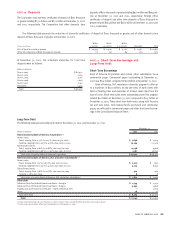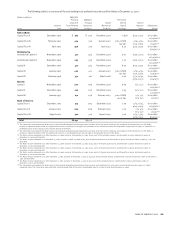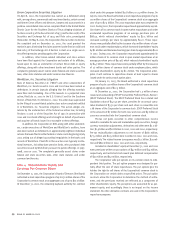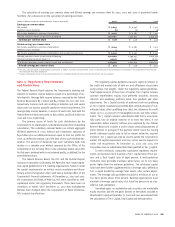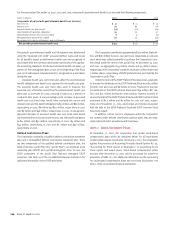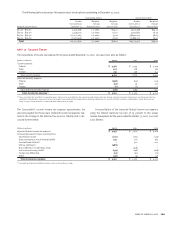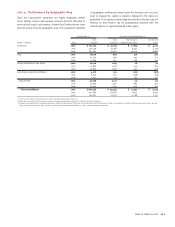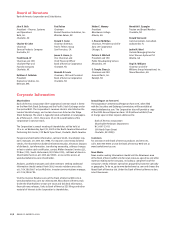Bank of America 2002 Annual Report Download - page 104
Download and view the complete annual report
Please find page 104 of the 2002 Bank of America annual report below. You can navigate through the pages in the report by either clicking on the pages listed below, or by using the keyword search tool below to find specific information within the annual report.
102 BANK OF AMERICA 2002
Net periodic postretirement health and life expense was determined
using the “projected unit credit” actuarial method. Gains and losses
for all benefits except postretirement health care are recognized in
accordance with the minimum amortization provisions of the applica-
ble accounting standards. For the postretirement health care plans, 50
percent of the unrecognized gain or loss at the beginning of the fiscal
year (or at subsequent remeasurement) is recognized on a level basis
during the year.
Assumed health care cost trend rates affect the postretirement
benefit obligation and benefit cost reported for the health care plan.
The assumed health care cost trend rates used to measure the
expected cost of benefits covered by the postretirement health care
plans was 10.0 percent for 2003, reducing in steps to 5.0 percent in
2006 and later years. A one-percentage-point increase in assumed
health care cost trend rates would have increased the service and
interest costs and the benefit obligation by $5 million and $61 million,
respectively, in 2002, $6 million and $52 million, respectively, in 2001
and $9 million and $49 million, respectively, in 2000. A one-percent-
age-point decrease in assumed health care cost trend rates would
have lowered the service and interest costs and the benefit obligation
by $4 million and $52 million, respectively, in 2002, $4 million and
$45 million, respectively, in 2001 and $7 million and $40 million,
respectively, in 2000.
Defined Contribution Plans
The Corporation maintains a qualified defined contribution retirement
plan and a nonqualified defined contribution retirement plan. There
are two components of the qualified defined contribution plan, the
Bank of America 401(k) Plan (the “401(k) Plan”): an employee stock
ownership plan (ESOP) and a profit-sharing plan. Prior to 2001, the
ESOP component of the 401(k) Plan featured leveraged ESOP
provisions. See Note 14 of the consolidated financial statements for
additional information on the ESOP provisions.
The Corporation contributed approximately $200 million, $196 mil-
lion, and $163 million for 2002, 2001 and 2000, respectively, in cash and
stock which was utilized primarily to purchase the Corporation’s com-
mon stock under the terms of the 401(k) Plan. At December 31, 2002
and 2001, an aggregate of 44 million shares and 45 million shares,
respectively, of the Corporation’s common stock and 1 million shares and
2 million shares, respectively, of ESOP preferred stock were held by the
Corporation’s 401(k) Plan.
Under the terms of the ESOP Preferred Stock provision, payments
to the plan for dividends on the ESOP Preferred Stock were $5 million
for both 2002 and 2001 and $6 million for 2000. Payments to the plan
for dividends on the ESOP Common Stock were $34 million, $27 mil-
lion, and $22 million during the same periods. Interest incurred to
service the debt of the ESOP Preferred Stock and ESOP Common Stock
amounted to $0.3 million and $3 million for 2001 and 2000, respec-
tively. As of December 31, 2001, all principal and interest associated
with the debt of the ESOP Preferred Stock and ESOP Common Stock
have been repaid.
In addition, certain non-U.S. employees within the Corporation
are covered under defined contribution pension plans that are sepa-
rately administered in accordance with local laws.
NOTE 17 Stock Incentive Plans
At December 31, 2002, the Corporation had certain stock-based
compensation plans which are described below. For all stock-based
compensation awards issued prior to January 1, 2003, the Corporation
applies the provisions of Accounting Principles Board Opinion No. 25,
“Accounting for Stock Issued to Employees,” in accounting for its
stock option and award plans. Stock-based compensation plans
enacted after December 31, 2002 will be accounted for under the
provisions of SFAS 123. For additional information on the accounting
for stock-based compensation plans and pro forma disclosures, see
Note 1 of the consolidated financial statements.
For the years ended December 31, 2002, 2001 and 2000, net periodic postretirement benefit cost included the following components:
(Dollars in millions)
2002 2001 2000
Components of net periodic postretirement benefit cost (income)
Service cost $11 $11 $11
Interest cost 67 65 58
Expected return on plan assets (17) (21) (20)
Amortization of transition obligation 32 32 37
Amortization of prior service cost (credit) 64 (3)
Recognized net actuarial loss (gain) 40 20 (45)
Recognized loss due to settlements and curtailments ––20
Net periodic postretirement benefit cost $139 $ 111 $ 58



